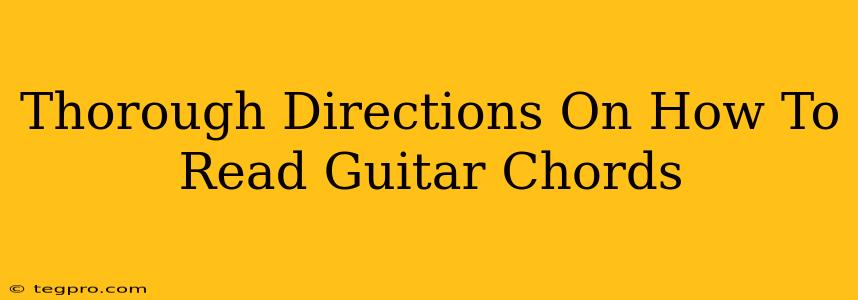So, you're ready to dive into the wonderful world of guitar chords? Fantastic! Learning to read guitar chords is the key to unlocking countless songs and styles. This guide will give you thorough directions, breaking down the process step-by-step, so you'll be strumming along in no time.
Understanding Guitar Chord Diagrams
The first thing you'll encounter when learning chords is the chord diagram. These diagrams are like mini-maps of your fretboard. Don't let them intimidate you; they're surprisingly simple once you understand the basics.
Deciphering the Diagram
A typical chord diagram looks like this (though the specific layout might vary slightly):
- Six Horizontal Lines: These represent the six strings of your guitar, from thickest (lowest pitch) at the bottom to thinnest (highest pitch) at the top.
- Vertical Numbers: These numbers indicate the frets. A "0" means you play the string open (without pressing down any fret).
- Dots on the Lines: These dots show you which frets to press down on which strings. The number inside the dot sometimes indicates which finger to use (1 = index finger, 2 = middle finger, 3 = ring finger, 4 = pinky finger).
- "X" Marks the Spot: An "X" means you don't play that string at all.
Example: Let's say you see a dot on the second fret of the 6th string. That means you press down on the 6th string at the second fret.
Practicing Your First Chords
Let's start with a few fundamental chords, focusing on the process of reading their diagrams and transferring that to your guitar.
The G Major Chord
This is a common chord found in countless songs. Look for a diagram of a G major chord. You'll likely see something like this:
- 6th string: 3rd fret (often indicated with a "3")
- 5th string: 0 (open string)
- 4th string: 0 (open string)
- 3rd string: 0 (open string)
- 2nd string: 2nd fret (often indicated with a "2")
- 1st string: 3rd fret (often indicated with a "3")
Practice Tip: Place your fingers gently but firmly on the indicated frets. Make sure to strum across all the strings involved in the chord. Experiment with different strumming patterns!
The C Major Chord
The C major chord is another cornerstone of guitar playing. Again, find its diagram. The placements will vary, but the key is to note the fret numbers for each string.
Practice Tip: Once you've mastered the G major, the C major will feel easier. Focus on finger placement and consistent strumming.
The D Major Chord
The D major chord can be a bit trickier initially. Use the diagram to guide your finger placement, paying attention to the fret numbers and any "X"s indicating strings not to play.
Practice Tip: Be patient; it takes time to develop finger strength and coordination. Don't get discouraged if it doesn't sound perfect immediately.
Beyond the Basics: Adding Nuance
Once you are comfortable with a few basic chords, you can start exploring variations. Some diagrams might show bar chords, where one finger presses down multiple strings at once, or other techniques to enhance your playing.
Pro-Tip: Use online resources and videos to visualize the process. There are countless tutorials available showing you exactly how to finger each chord.
Mastering Chord Transitions
The real skill comes in smoothly transitioning between chords. This requires practice and coordination.
Practice Tip: Start by slowly changing between two chords (e.g., G to C). Once you're comfortable, gradually increase your speed.
With consistent practice and a focus on understanding chord diagrams, you'll be reading and playing guitar chords with confidence in no time! Remember to be patient with yourself and enjoy the process of learning. Happy strumming!

